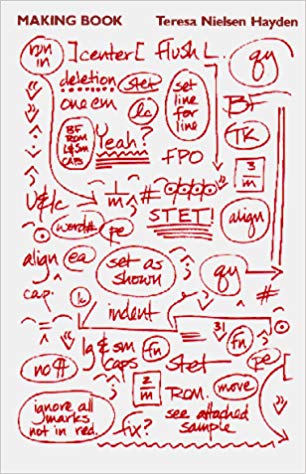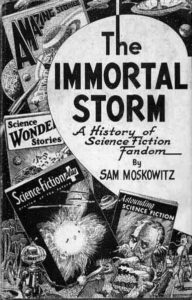(1) DRESSING UP. An 11-minute video of cosplay at San Diego Comic-Con.
San Diego Comic Con 2019, at the San Diego Convention Center. In its 50th year it was an hectic and news worthy convention with some really great costumes and creativity, thanks everyone for participating
(2) DUBLIN 2019 REMINDERS. The Hugo voting deadline is upon us —
Voting will end on 31 July 2019 at 11:59pm Pacific Daylight Time (2:59am Eastern Daylight Time, 07:59 Irish and British time, all on 1 August)
Also, Dublin 2019 invites members to take the survey — “Consider participating in a research study that is collecting data on Worldcon attendees.”
Want to Help Out Science?
Professor Jennifer Zwahr-Castro is researching Worldcon, and investigating why we attend and what we get out of the experience. She would like to invite all Dublin 2019 attendees to take part in her research by filling out a survey.
(3) THE CHERRY ON THE TOP OF MT. TBR. An email from NESFA Press tells me they are pleased to announce two new ebooks available immediately–
- Moskowitz, Sam, The Immortal Storm (978-1-61037-334-0)
- Nielsen Hayden, Teresa, Making Book (978-1-61037-333-3)
(4) CLOSE READING. [Item by rcade.] Catherynne Valente tweeted that in 15 years writing professionally, she doesn’t think she’s ever described the size of a woman’s breasts.
After some internal debate over whether I should, I broke the news to her that she had.
The overall thread has a lot of hilarious stuff in it. It starts here.
(5) BOOKER PRIZE LONGLIST. Margaret Atwood’s inclusion on the 2019 Book Prize Longlist was reported in yesterday’s Scroll – but here’s the complete list, or ‘Booker Dozen’, as the cognoscenti say.
This year’s longlist of 13 books was selected by a panel of five judges: founder and director of Hay Festival Peter Florence (Chair); former fiction publisher and editor Liz Calder; novelist, essayist and filmmaker Xiaolu Guo; writer, broadcaster and former barrister Afua Hirsch; and concert pianist, conductor and composer Joanna MacGregor.
The 2019 longlist, or ‘Booker Dozen’, of 13 novels, is:
- Margaret Atwood (Canada), The Testaments (Vintage, Chatto & Windus)
- Kevin Barry (Ireland), Night Boat to Tangier (Canongate Books)
- Oyinkan Braithwaite (UK/Nigeria), My Sister, The Serial Killer (Atlantic Books)
- Lucy Ellmann (USA/UK), Ducks, Newburyport (Galley Beggar Press)
- Bernardine Evaristo (UK), Girl, Woman, Other (Hamish Hamilton)
- John Lanchester (UK), The Wall (Faber & Faber)
- Deborah Levy (UK), The Man Who Saw Everything (Hamish Hamilton)
- Valeria Luiselli (Mexico/Italy), Lost Children Archive (4th Estate)
- Chigozie Obioma (Nigeria), An Orchestra of Minorities (Little Brown)
- Max Porter (UK), Lanny (Faber & Faber)
- Salman Rushdie (UK/India), Quichotte (Jonathan Cape)
- Elif Shafak (UK/Turkey), 10 Minutes 38 Seconds in This Strange World (Viking)
- Jeanette Winterson (UK), Frankissstein (Jonathan Cape)
The list was chosen from 151 novels published in the UK or Ireland between 1 October 2018 and 30 September 2019.
(6) BIG BRAINS. Kicking off today in Dublin, a “Theorizing Zombiism Conference”:

The rising academic interest in the zombie as an allegory for cultural and social analysis is spanning disciplines including, humanities, anthropology, economics, and political science. The zombie has been used as a metaphor for economic policy, political administrations, and cultural critique through various theoretical frameworks. The zombie has been examined as a metaphor for capitalism, geopolitics, globalism, neo-liberal markets, and even equating Zombiism to restrictive aspects of academia.
Apparently it is not a joke:
(7) DO YOU WANT TO PLAY A GAME? NPR asks “Can This Group Of Teen Girls Save The World From Nuclear War?”
On a recent morning, 15 teenage girls and young women reported for duty at an office overlooking the Pentagon. Their mission: Save the world from nuclear war.
“This is where I want you to stop being you,” said Stacie Pettyjohn, a political scientist at the RAND Corporation, a defense think tank. “You’re going to have to start to role-play.”
Pettyjohn was leading a war-game exercise on North Korea. Typically, military commanders and policymakers use war gaming to test strategies and their likely consequences. But nothing about this game was typical. It was designed by women — RAND’s “Dames of War Games” — for teenagers from Girl Security, a nonprofit that introduces girls to defense issues. The partnership was a first for both groups; it’s among a series of recent efforts to boost women’s participation in national security.
“You have to fight,” Pettyjohn told the teens. “You are the military commanders.”
The scenario Pettyjohn laid out was bleak. U.S. talks with North Korea had collapsed, and deadly tit-for-tat attacks had spiraled into open conflict on the Korean Peninsula. Half the teens would join the blue team, assuming the roles of U.S. and allied South Korean generals. The others went to the red team, playing North Korean leaders determined to stay in power.
(8) SOMEDAY MY BLUEPRINTS WILL COME. Curbed’s Angela Serratore shares credit with architects of the Eighties and Nineties for corporate Disney’s current world domination: “The magical (postmodern) world of Disney”.
It was 1991 and Michael Eisner was on the brink of changing everything.
After becoming the CEO of the Walt Disney Company in 1984, Eisner, a native New Yorker, set out to turn the old-fashioned Disney brand into one that would speak not just to the present moment but also, crucially, to the future. During his tenure, the company would eventually acquire the television network ABC and the sports behemoth ESPN and produce films that would come to define the Disney Renaissance—The Little Mermaid, Beauty and the Beast, The Lion King, and Aladdin, among others.
An amateur architecture and design buff, Eisner also understood that a company like Disney ought to have a real presence—theme parks, of course, but also office buildings, studios, and hotels. What if, his design philosophy seemed to suggest, people could look up at Disney headquarters in Burbank or Orlando and feel the same awe and delight they must’ve felt on Disneyland’s opening day?
(9) DRAWN THAT WAY. A tour of the exhibit led by Lucas Adams: “Worlds Apart: Sci-Fi Visions of Altered Reality” at New York Review of Books.
We all wish we could change the past, at least some of the time. Relationships, elections, conversations: there are countless moments in our lives we’d love the chance to rework, or simply reimagine. Living in an era when we can easily tweak the small (delete a sentence, crop an image) but feel helpless when facing the large (political turmoil, climate change), it’s hard not to fantasize about reworking our histories.
But this inclination is not new. Attempting to rework the past, at least on paper, has been the outlet of artists and authors for as long as people have been wishing for different endings. “As If: Alternative Histories From Then to Now,” an exhibition at the Drawing Center, presents eighty-four works from 1888 to the present that “offer examples of how we might reimagine historical narratives in order to contend with the traumas of contemporary life.”
(10) TODAY’S BIRTHDAYS.
[Compiled by Cat Eldridge.]
- Born July 25, 1907 — Cyril Luckham. He played the White Guardian on Doctor Who. He appeared in The Ribos Operation episode, The Key to Time season during the Era of the Fourth Doctor, and the Enlightenment story during the Era of the Fifth Doctor. He was also Dr. Meinard in the early Fifties Stranger from Venus (a.k.a. Immediate Disaster and The Venusian). (Died 1989.)
- Born July 25, 1921 — Kevin Stoney. He appeared in three serials of the science fiction series Doctor Who over a period of ten years, playing Mavic Chen in The Daleks’ Master Plan during the time of the First Doctor, Tobias Vaughn in The Invasion during the time of the Second Doctor and Tyrum in Revenge of the Cybermen during the time of the Fourth Doctor. Other genre credits include: The Adventures of Robin Hood, Danger Man, The Avengers, The Prisoner, Doomwatch, The Tomorrow People, Space: 1999, The New Avengers, Quatermass, and Hammer House of Horror. (Died 2008.)
- Born July 25, 1922 — Evelyn E. Smith. She has the delightful bio being of a writer of sf and mysteries, as well as a compiler of crossword puzzles. During the 1950s, she published both short stories and novelettes in Galaxy Science Fiction, Fantastic Universe and The Magazine of Fantasy & Science Fiction. Her SF novels include The Perfect Planet and The Copy Shop. A look at iBooks and Kindle shows a twelve story Wildside Press collection but none of her novels. (Died 2000.)
- Born July 25, 1937 — Todd Armstrong. He’s best known for playing Jason in Jason and the Argonauts. A film of course that made excellent by special effects from Ray Harryhausen. His only other genre appearance was on the Greatest American Hero as Ted McSherry In “ A Chicken in Every Plot”. (Died 1992.)
- Born July 25, 1948 — Brian Stableford, 71. I am reasonably sure that I’ve read and enjoyed all of the Hooded Swan series a long time ago which I see has been since been collected as Swan Songs: The Complete Hooded Swan Collection. And I’ve certainly read a fair amount of his short fiction down the years.
- Born July 25, 1973 — Mur Lafferty, 46. Podcaster and writer. Co-editor of the Escape Pod podcast with Divya Breed, her second time around. She is also the host and creator of the podcast I Should Be Writing which won aParsec Award for Best Writing Podcast. She is also the Editor-in-Chief of the Escape Artists short fiction magazine Mothership Zeta. And then there’s the Ditch Diggers podcast she started with Matt Wallace which is supposed to show the brutal, honest side of writing. For that, it won the Hugo Award for Best Fancast in 2018, having been a finalist the year before. Fiction-wise, I loved both The Shambling Guide to New York City and A Ghost Train to New Orleans with I think the second being a better novel.
(11) COMICS SECTION.
- Incidental Comics by Grant Snider –
(12) FAILURE TO IMAGINATE. “Twitter’s retweet inventor says idea was ‘loaded weapon'” – BBC has the story.
The man who came up with Twitter’s retweet button has likened it to “handing a four-year-old a loaded weapon”, in an interview with BuzzFeed.
Developer Chris Wetherell said no-one at Twitter had anticipated how it would alter the way people used the platform.
…He told BuzzFeed that he thought the retweet button “would elevate voices from under-represented communities”.
Previously people had to manually retweet each other by copying text and typing RT and the name of the tweeter but once the process was automated, retweeting meant popular posts quickly went viral.
While some went viral for good reasons, such as providing information about natural disasters, many others were not so benign.
Gamergate – a harassment campaign against women in the games industry – was one example of how people used the retweet to co-ordinate their attacks, Wetherell told BuzzFeed, describing it as a “creeping horror story”.
“It dawned on me that this was not some small subset of people acting aberrantly. This might be how people behave. And that scared me to death.”
(13) CRASH TEST DUMMIES? BBC wonders “Why is India sending humanoid robots into space?” Me too.
Before humans headed up there, animals were the first living creatures that were sent into space. But India will now become the first nation to fly a spacecraft with only humanoid robots. Science writer Pallava Bagla reports.
The Indian government has sanctioned $1.4bn (£1.1bn) to the Indian Space Research Organisation (Isro) for its first manned space flight by 2022.
…To date – using indigenously made rockets – Russia, the US and China have sent astronauts into space. If India can achieve this, it will become the fourth country to launch humans into space from its own soil.
But, unlike other nations that have carried out human space flights, India will not fly animals into space. Instead, it will fly humanoid robots for a better understanding of what weightlessness and radiation do to the human body during long durations in space.
(14) FLYING TO FEAR. A BBC video details “The Nasa astronauts on a mythical mission to Mars moon”.
Nasa is finding out how people cope with the demands of long space missions at its Human Exploration Research Analog (Hera).
For 45 days a crew of four people live in a habitat which simulates a mission to Phobos, a moon that orbits the planet Mars.
The crew carry out daily maintenance tasks on board, enjoy views of space from the capsule window and keep in contact with mission control via a five minute delay, meaning that a response to a communication takes 10 minutes.
(15) REASONS TO VOTE. Joe Sherry ranks the YA award contenders in “Reading the Hugos: Lodestar” at Nerds of a Feather.
…Generally, it takes a novel that breaks out of the YA spaces and gains visibility in some of the more SFF communities that I engage with (see, Children of Blood and Bone) or has some aspect that catches the attention of those communities (see, Dread Nation) or are beloved by commentators I deeply admire and respect (see, Tess of the Road). Also, I almost said the “wider SFF communities”, but that would not have been correct because YA publishing and readership is absolutely huge and has a significant overlap in science fiction and fantasy that should not be understated.
This is all to say that I was familiar with three of the novels on the ballot, and I was excited to read everything here to see which novels would break out into my list of new favorites. At least one, and let’s find out which….
(16) THIS IDEA COULD CRATER. Looking at both sides of the question:“Hawaii TMT: Desecrating sacred land or finding new frontiers?”
Rifts over a dormant volcano in Hawaii have resurfaced in recent days, pitting the state’s culture and history against its ambitions.
Plans for a powerful new telescope near the summit of the Mauna Kea volcano could bring in hundreds of jobs and boost science and the economy. But some native Hawaiians insist the site is sacred and that the long-planned construction should not go ahead.
Last week, protesters blocked access to the building site on Mauna Kea, the tallest mountain in the world when measured from its underwater base. At least 33 people were arrested, given citations and released.
Hawaii’s governor has issued an “emergency proclamation” that increases powers to break up the blockade but said he wanted to find a “peaceful and satisfactory” solution for both sides.
Here, some of the people at the centre of the debate explain what Mauna Kea and the Thirty Meter Telescope (TMT) project mean to them.
(17) AUTO-BUY. Adri Joy’s faith in an author is repaid: “Microreview [Book]: Gods of Jade and Shadow by Silvia Moreno-Garcia” at Nerds of a Feather.
Silvia Moreno-Garcia is an author I’d follow into almost any genre, and that’s a good thing given how varied her career has been so far. From the 80’s nostalgia-heavy Signal to Noise to the romance fantasy of manners The Beautiful Ones, to the criminally underrated sci-fi novella Prime Meridian and even the editorial work she does on The Dark Magazine (a recent addition to my short fiction rounds), Garcia brings talent, nuance and a particular eye for female characters challenging overwhelming imbalances in power over the forces against them. Now, in Gods of Jade and Shadow, Moreno-Garcia brings her talents to a historic fantasy where 1920’s Jazz Age Mexico meets the gods and monsters of Mayan mythology, taking protagonist Casiopea Tun on an unexpected but long-dreamed-of adventure with a deposed Lord of the Underworld….
(18) SPLASH. The flyer from a recent Pixel tried something a lot harder — “Franky Zapata: Flyboard inventor fails in cross-Channel bid”.
A French inventor has failed in his attempt to cross the English Channel on a jet-powered flyboard.
Franky Zapata, a former jet-ski champion, had been hoping to cross from northern France to southern England in just 20 minutes.
But the 40-year-old fell into the water halfway across as he tried to land on a boat to refuel.
He took off from near Calais on Thursday morning and was heading for St Margaret’s Bay in Dover.
Mr Zapata was not injured when he fell and later announced he was planning a second bid to fly across the Channel next week.
(19) FIRE ONE. James Gleick traces the long, fictional effort to infect Earthlings with “Moon Fever” at New York Review of Books.
…The first moon landing was at once a historical inevitability and an improbable fluke. Inevitable because we had already done it so many times in our storytelling and our dreams. Astonishing, even in hindsight, because it required such an unlikely combination of factors and circumstances. “The moon, by her comparative proximity, and the constantly varying appearances produced by her several phases, has always occupied a considerable share of the attention of the inhabitants of the earth,” remarks Jules Verne in his fantastic tale From the Earth to the Moon (1865). The French fabulist imagined that the pioneers of space would be none other than Les Yankees: “They had no other ambition than to take possession of this new continent of the sky, and to plant upon the summit of its highest elevation the star-spangled banner of the United States of America.”
To get there, Verne proposed a projectile fired from a giant gun. He had probably read Edgar Allan Poe’s story “The Unparalleled Adventure of One Hans Pfaall” (1835), in which a Dutchman journeys to the moon by lighter-than-air balloon and meets the inhabitants, “ugly little people, who none of them uttered a single syllable, or gave themselves the least trouble to render me assistance, but stood, like a parcel of idiots, grinning in a ludicrous manner.” Like Poe, Verne embellished his story with a great deal of plausible science involving computations of the moon’s elliptical orbit, the distances to be traveled at apogee or perigee, the diminishing force of gravitation, and the power of exploding gunpowder….
(20) FACTS AND FIGURES. BBC updates readers on “Climate change: Current warming ‘unparalleled’ in 2,000 years”.
The speed and extent of current global warming exceeds any similar event in the past 2,000 years, researchers say.
They show that famous historic events like the “Little Ice Age” don’t compare with the scale of warming seen over the last century.
The research suggests that the current warming rate is higher than any observed previously.
The scientists say it shows many of the arguments used by climate sceptics are no longer valid.
When scientists have surveyed the climatic history of our world over the past centuries a number of key eras have stood out.
These ranged from the “Roman Warm Period”, which ran from AD 250 to AD 400, and saw unusually warm weather across Europe, to the famed Little Ice Age, which saw temperatures drop for centuries from the 1300s.
The events were seen by some as evidence that the world has warmed and cooled many times over the centuries and that the warming seen in the world since the industrial revolution was part of that pattern and therefore nothing to be alarmed about.
Three new research papers show that argument is on shaky ground.
The science teams reconstructed the climate conditions that existed over the past 2,000 years using 700 proxy records of temperature changes, including tree rings, corals and lake sediments. They determined that none of these climate events occurred on a global scale.
(21) TRAILER PARK. From the novel The Future of Another Timeline, by Annalee Newitz, comes a riot grrl band called Grape Ape. They are lost to our timeline, but you can see them here in all their glory. The Future of Another Timeline comes out from Tor Books on Sept. 24, 2019.
[Thanks to rcade, JJ, John King Tarpinian, Andrew Porter, Carl Slaughter, Martin Morse Wooster, Mike Kennedy, Chip Hitchcock, Michael Toman, mlex, Anthony Lewis, and Cat Eldridge for some of these stories. Title credit goes to File 770 contributing editor of the day Anna Nimmhaus.]



